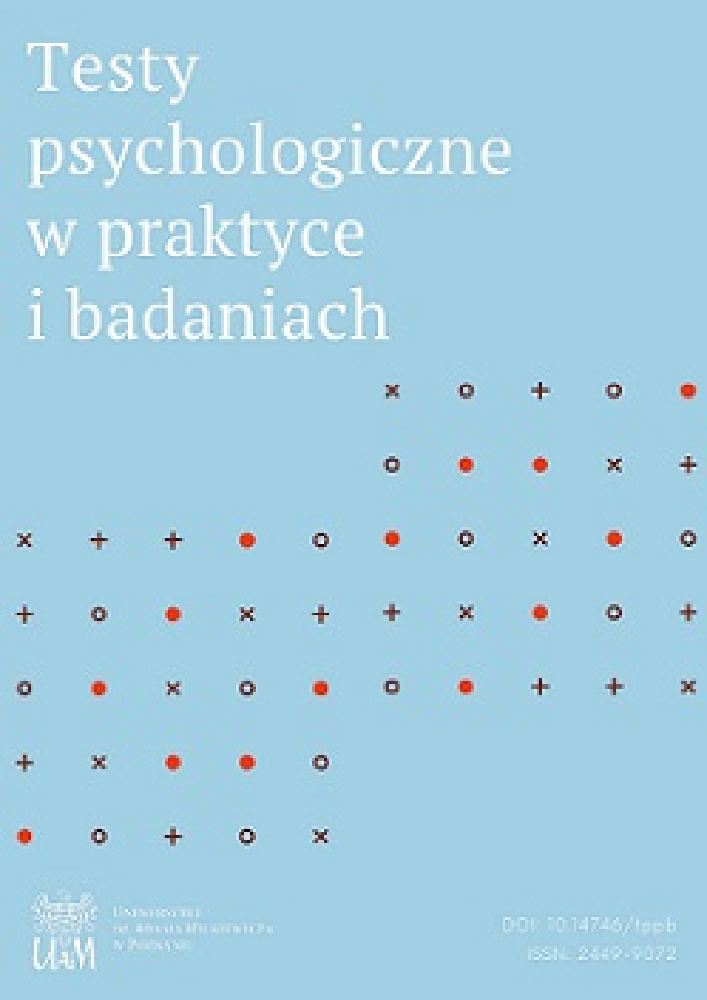Abstrakt
Celem niniejszego badania była weryfikacja korelacji między polskimi testami zadaniowymi służącymi do pomiaru inteligencji emocjonalnej (EI) lub komponentów EI. W badaniu udział wzięły 43 osoby ze Stowarzyszenia Mensa Polska. Otrzymane wyniki wykazały dodatnią korelację między TRE i TIE (r=0,30 p<0,05) oraz ujemną korelację między SIE-T i TRE (r=-0,28, p<0,05). Korelacja między SIE-T i TIE okazała się nieistotna.
Bibliografia
Barchard, K. A., Hakstian, A. R. (2004). The nature and measurement of emotional intelligence abili-ties: Basic dimensions and their relationships with other cognitive ability and personality vari-ables. Educational and Psychological Measurement, 64, 437–462.
Bar-On, R. (1997). Bar-On Emotional Quotient Inventory (EQ-i): Technical manual. Toronto, Canada: Multi-Health Systems.
Boyd, D. Bee, H. (2006). Lifespan Development. Boston: Allyn i Bacon.
Brackett, M. A., Mayer, J. D. (2003). Convergent, discriminant, and incremental validity of competing measures of emotional intelligence. Personality and Social Psychology Bulletin, 29, 1147-1158.
Brackett, M. A., Rivers, S. R., Lerner, N., Salovey, P.,Shiffman, S. (2006). Relating emotional abilities to social functioning: A comparison of self-report and performance measures of emotional in-telligence. Journal of Personality and Social Psychology, 4, 780-795.
Darksen, J., Kramer, I. Katzko, M. (2009). Does a self-report measure for emotional intelligence as-sess something different then general intelligence. Personality and Individual Differences, 32, 37-48.
Dawda, D., Hart, S. D. (2000). Assessing emotional intelligence: Reliability and validity of the Bar-On Emotional Quotient Inventory (EQ-i) in university students. Personality and Individual Differ-ences, 28, 797-812.
Goldenberg, I., Matheson, K., Mantler, J. (2006). The Assessment of Emotional Intelligence: A Com-parison of Performance-Based and Self-Report Methodologies. Journal of PersonalityAssess-ment,86, 33-45.
Goleman, D. (1997). Inteligencja emocjonalna. Poznań: Media Rodzina.
Jaworowska, A., Matczak, A. (2005). PKIE - Popularny Kwestionariusz Inteligencji Emocjonalnej. Podręcznik. Warszawa: Pracownia Testów Psychologicznych Polskiego Towarzystwa Psycho-logicznego.
Lubikowska, A. (2013). Sprawność wykorzystywania inteligencji emocjonalnej u osób o wysokim poziomie inteligencji ogólnej. Niepublikowana praca magisterska. Poznań: Uniwer-sytet im. Adama Mickiewicza, Instytut Psychologii.
Matczak, A. (2007). Rola inteligencji emocjonalnej. Studia Psychologiczne, 45, 9-17.
Matczak, A., Piekarska, J. (2011). Test Rozumienia Emocji (TRE). Podręcznik. Warszawa: Pracownia Testów Psychologicznych Polskiego Towarzystwa Psychologicznego.
Matczak, A., Piekarska, J., Studniarek, E. (2005). Skala Inteligencji Emocjonalnej – Twarze (SIE-T). Podręcznik. Warszawa: Pracownia Testów Psychologicznych Polskiego Towarzystwa Psycho-logicznego.
Mayer, J. D.,Salovey, P. (1997). What is emotional intelligence? W: P. Salovey, D. Sluyter (red.), Emotional development and EI: Educational implications (str. 3–34). New York: Basic Books.
Mayer, J. D., Salovey, P., Caruso, D. (2002). Mayer–Salovey–Caruso Emotional Intelligence Test: User’s manual. Toronto, Ontario, Canada: Multi-Health Systems.
Mayer, J. D., Salovey, P., Caruso, D. (2004). Emotional intelligence: Theory, findings and implica-tions. Psychological Inquiry, 15, 197–215.
Mayer, J.D., Salovey, P., Caruso, P.,Sitarenios, G. (2001). Emotional Intelligence as a Standard Intelligence. Emotion, 3, 232–242.
Nail, J. M., Evans, J. G. (1997). The emotional adjustment of gifted adolescents: A view of global functioning. Roeper Review, 20, 18-21.
Newsome, S., Day, A. L.,Catano, V.M. (2000). Assessing the predictive validity of emotional intelli-gence. Personality and IndividualDifferences, 29, 1005-1016.
Parker, W. D. (1996). Psychological adjustment in mathematically gifted students. Gifted Child Quar-terly, 40, 154-157.
Pérez, J. C., Petrides, K. V., Furnham, A. (2005). Measuring trait emotional intelligence. W: R. Schulze and R. D. Roberts (red.), International Handbook of Emotional Intelligence. Cambridge, MA: Hogrefei Huber.
Petrides, K.V.Furnham, A. (2000). Gender differences in measured and self-estimated trait emotional intelligence. Sex Roles , 42, 449-461.
Rivers, S. (2005). Measurement issues in emotional intelligence research: Predicting social outcomes. Paper presented at the annual meeting of the Society of Personality and Social Psychology, New Orleans, LA.
Salovey, P., Mayer, J. D. (1990). Emotional intelligence. Imagination, Cognition, and Personality, 9, 185–211.
Schutte, N. S.,Malouff, J.M., Hall, L. E., Haggerty, D. J., Cooper, J. T., Golden, C. J., et al. (1998). Development and validation of a measure of emotional intelligence. Personality and Individu-al Differences, 25, 167-177.
Śmieja, M., Orzechowski, J. (2008). Inteligencja emocjonalna. Fakty, mity, kontrowersje. Warszawa: PWN.
Śmieja, M., Orzechowski, J. Asanowicz, D. (2012). Test Inteligencji Emocjonalnej (TIE). Podręcznik. Kraków: Wszechnica Uniwersytetu Jagiellońskiego.
Szczygieł, D. (2008). Inteligencja emocjonalna – więcej niż IQ i osobowość? O potrzebie i znaczeniu sprawdzania trafności dodanej narzędzi mierzących inteligencję emocjonalną. W: M. Śmieja, J. Orzechowski (red.). Inteligencja emocjonalna. Fakty, mity, kontrowersje (str. 136-152). Warszawa: PWN.
Taracha, M. (2010). Inteligencja emocjonalna a wykorzystanie potencjału intelektualnego.Lublin: WydawnictwoUniwersytetuMarii Curie – Skłodowskiej.
Terman, L. M. (1925). Mental and physical traits of a thousand gifted children. Stanford, CA: Stanford University Press.
Zeidner, M., Shani - Zinovich, I., Matthews, G. Roberts, R. (2005). Assessing emotional intelligence in gifted and non-gifted high school students: Outcomes depend on the measure. Intelligence, 33, 369 – 391.
